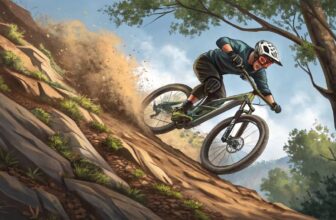Understanding MTB Suspension
Mountain bike suspension plays a big part in making sure your ride is as smooth as butter on hot toast. It influences how your bike handles, your stability, and the overall fun factor. Get your suspension right, and it’s like riding on clouds while still feeling super connected to the ground.
Making Sense of Suspension Setup
Why bother with a good suspension setup? Simple—it keeps you in control and comfy no matter what nature throws your way. Without the right adjustments, you’re more likely to crash, tire out, or feel like you’re wrestling a wild bronco down the trail.
When your bike hits roots, rocks, or rough patches, the suspension eats up those jolts like a snack, keeping things smooth and steady. The trick is finding the sweet spot between a sensitive ride and good support, so the bike can handle everything from pebbles to potholes. The folks over at ENDURO Mountainbike Magazine reckon that nailing this balance is the secret to rocking a killer suspension setup.
What’s the Deal with SAG?
SAG—yep, it’s all about how much your suspension squishes under your weight. It can change how your bike handles, how you sit on it, and how it rolls down the path. Always check your SAG when you’re geared up and ready to ride.
How SAG Levels Change the Game
| SAG Level | How It Changes Bike Handling | How It Feels for You |
|---|---|---|
| Less SAG | Cuts down on bounce when pedaling, bumps feel harder | Feels rougher |
| More SAG | Glides over small bumps but loses pedaling juice | Feels smoother |
- Less SAG: Cuts down on the bike bouncing under you when pedaling, but it’s gonna feel harsh over little bumps.
- More SAG: Smooth out those little road bumps, but don’t expect to win any races—your pedaling might feel squishy.
SAG tweaks can also mess with how your bike handles:
- Zipping Along Faster: A bit more SAG can keep things stable when you’re flying down hills.
- Nailing Those Turns: Too much SAG could make sharp turns feel sketchy.
- Carving Corners: Play with SAG settings to see what’s best for how you ride. More SAG might make cutting sharp turns tricky.
For anyone who’s new or has some trail experience, getting your SAG just right can seriously step up your ride game. For more hands-on tips, check out our pieces on suspension setup basics and mountain bike maintenance.
Understand your suspension and how SAG tweaks your ride, and you’ll tune your bike to fit like your favorite old sneakers while conquering the trails ahead.
Suspension and Riding Experience
Getting the right setup for your mountain bike’s suspension is a game-changer for how you ride, how you handle the bike, and how your body stays comfy and balanced.
Handling and Stability
Your mountain bike handles and sticks to the ground better when the suspension’s dialed in. There’s this little thing called SAG (Suspension Active Ground) that plays a big part in how well you can whip around corners and stay solid at high speeds. You should mess around with different SAG settings to see what works for the trails you love.
Crank up the SAG if you want more stability, although you’ll trade off a bit of that sticky front-end grip and agility around bends. If you opt for less SAG, you’d get more bite at the front and nimbleness, but things might get a tad wobbly at speed.
For a fine-tuned ride, balance your setup by playing with traction and support. Here’s a quick look at how SAG tweaks ride performance:
| SAG Setting | High-Speed Stability | Front-End Traction | Cornering Ability |
|---|---|---|---|
| Beefy SAG | More stable | Less grip | Less nimble |
| Light SAG | Less stable | More grip | More nimble |
Striking the right balance often means tweaking rebound and damping settings based on how you ride and the trails you hit. Scope out our mtb suspension setup guide to dig deeper.
Body Position Optimization
Your suspension’s got a direct line to how you settle on the bike. More SAG shifts your weight back for rock-solid high-speed runs but costs you some front-end bite. Go low on SAG, and you’ll get that weight forward, perfect for tight cornering at the expense of speed stability.
Getting your body position right isn’t just about dialing in handling—it helps with comfort and makes your ride more chill and efficient. By tweaking your SAG, compression, and rebound, you’re looking at better control and less weariness on those long epic trails. For more tricks on getting that ideal body spot, check out our mtb body position article.
Fiddling with high-speed compression (HSC) and low-speed compression (LSC) tweaks how your bike handles bumps and rebounds.
Hop on over to our MTB suspension setup guide to dial in your settings and max out your ride fun!
Suspension Setup Basics
Setting up mountain bike suspension right makes all the difference on the trails. Get it wrong, and you’re flirting with disaster; get it right, and you’ve got smooth sailing all the way. We’ll break it down for you, focusing on two biggies: rebound damping and compression tuning.
Rebound Damping Adjustment
The magic of rebound damping is all about how fast your suspension bounces back after taking a hit. Nail this, and your bike will glide over the trails like butter. But mess it up, and you’re in for a ride that’s either a jack-in-the-box or a squishy mess (Worldwide Cyclery). Adjusting rebound is key. Here’s the lowdown:
- Set Sag: First step, make sure the sag is spot on so your suspension hugs your weight just right.
- Initial Settings: Kick off with what the pros at the factory suggest.
- Hit the Trails: Cruise over mixed terrains and play with the rebound knob. Righty-tighty usually slows things down; lefty-loosey speeds it up.
- Refine: Make tiny tweaks and see how it changes the vibe of the ride.
| Rebound Setting | Ride Feel |
|---|---|
| Too Fast | It’s bouncy castle time! |
| Too Slow | Feels like riding through molasses |
Compression Tuning Techniques
Compression damping keeps your suspension from caving in like a cheap tent under a load. Think of it as the brakes on runaway movement, crucial for taming rough terrains.
Compression adjustments come in two flavors: High-Speed (HSC) and Low-Speed (LSC). They’re like the dynamic duo that saves your ride from going off the rails.
- High-Speed Compression (HSC): Deals with big hits like jumping and bull-in-a-china-shop-type runs.
- Low-Speed Compression (LSC): Bosses the slow stuff, like carving through a banked turn.
Tuning Steps:
- Start with Factory Presets: You gotta start somewhere, right?
- Tweak HSC: Beef it up or dial it down for those cannonball impacts without hitting rock bottom.
- Fuss with LSC: Tinker for better pedaling and cornering.
- Real-World Testing: Get out there, ride, tweak, repeat until it’s silky smooth.
| Compression Setting | Ride Feel |
|---|---|
| Too Firm (HSC/LSC) | Feels like riding a brick |
| Too Soft (HSC/LSC) | Feels like a marshmallow |
Getting the knack of your bike’s suspension dramatically ups your fun meter on the trails. Always peek at the manufacturer’s playbook, and don’t be shy about seeking a pro’s wisdom. For more bike know-how, swing by our guides on mountain bike maintenance and the mtb rear shock guide.
Parts That Make Up a Mountain Bike’s Suspension
If you’re hitting those bumpy trails, getting to know the ins and outs of your mountain bike’s suspension can be your best bet for nailing a smoother ride. There are two main characters in our story here: the front suspension (better known as forks) and the rear suspension (shocks). Each part helps keep your rides as smooth as butter over jaw-rattling terrain.
Front Suspension (Forks)
The front suspension—what mountain bikers fondly call forks—is a bit of an unsung hero. It takes the edge off those nasty bumps and crunches. Here’s the low-down on what forks are made of:
- Steerer Tube: This is the bridge that ties your fork to your bike’s frame.
- Crown: Like a big boss, it holds the steerer and the stanchions in place.
- Stanchions: These tubes slide noiselessly into the lower and let the fork stretch and shrink.
- Lowers: They embrace the stanchions and house oil or air, making the magic happen.
- Dropouts: The front wheel’s parking spot.
- Brake Mounts: Where the disc brakes hitch a ride.
Most forks also come with bells and whistles like adjustable travel and dials for compression and rebound, so you can tune them just right for how wild or mild you plan to ride.
Some Fork Parts and Their Jobs:
| Component | Whatcha Gonna Do |
|---|---|
| Steerer Tube | Connects the fork to bike frame |
| Crown | Holds steerer tube and stanchions together |
| Stanchions | Allow for suspension movement |
| Lowers | Hold the oil or air for suspension |
| Dropouts | Secure the front wheel axle |
| Brake Mounts | Secure the disc brakes |
Rear Suspension (Shocks)
When we’re talking rear suspension, or just plain “rear shock,” we’re talking about a cushion for your backside and back wheel. Designed to suck up bumps and keep your wheels glued to the ground, rear shocks come with a few neat features:
- Spring (Air or Coil): Keeps the bike’s suspension at the right height and bears your weight like a champ.
- Damper: Conduction supervisor—overseeing how fast the shock compresses and rebounds.
- Pivot Designs: These come in all shapes and sizes, giving bikes that oh-so-smooth suspension vibe.
With a smart rear suspension, you’re all set for a comfy trail ride, that offers super grip and control.
Some Back Shock Bits:
| Component | Job Description |
|---|---|
| Spring (Air/Coil) | Maintains suspension height, supports rider |
| Damper | Manages compression and bounce back |
| Pivot Designs | Affects how shock works with bike frame |
Knowing these parts helps riders tweak and fine-tune their mtb suspension setup for the ultimate ride comfort and control on the trail. Check out our section on mountain bike maintenance for keeping things in shape.
Dive deeper into the suspension world by exploring guides like mtb fork maintenance to keep those fork parts shipshape. Also, peep our handy tips for mtb tire pressure and compare mountain bike brakes for the ultimate biking setup.
Types of Suspension Systems
When you’re out there tackling those gnarly mountain trails on your bike, the suspension system’s got your back, literally. It’s all about making your ride smooth, stable, and just straight-up awesome.
If you’re messing with your mountain bike (MTB) setup, you kinda need to know the ins and outs of the different suspension systems. Here’s a quick look at air forks versus coil forks, and short travel versus long travel.
Air Forks vs. Coil Forks
These two fork types have their own vibe, making them better for certain rides and terrain.
Air Forks:
- They use air (go figure) to keep that suspension going, so they’re lightweight and super versatile (Cykel House).
- Awesome for cross-country folks who are all about speed and climbing like a billy goat.
- Get softer at first then stiffen up more as you crank things up.
- Light as a feather, making those uphill battles less of a workout.
Coil Forks:
- With a trusty metal spring in there, they provide steady suspension, all day, every day.
- Perfect for riders who love it rough and tough and need that setup to just work, no matter what.
- Keep it cool and perform consistently, whether it’s boiling hot or freezing cold outside.
Need to decide? Here’s the scoop:
| Feature | Air Forks | Coil Forks |
|---|---|---|
| Weight | Light as a breeze | Packin’ some pounds |
| Adjustability | Change it up however | Not much wiggle room |
| Compression Rate | Softer at first | All smooth, all the time |
| Maintenance | Adjust air pressure often if you can | Low maintenance vibes |
| Ideal Use | XC and uphill heroes | Downhill devotees, rocky champs |
For more on keeping your ride tip-top, check out our mtb fork maintenance guide.
Short vs. Long Travel
“Travel” here is about how much your suspension compresses. That’s gonna change the way your bike handles dirt and rocks.
Short Travel:
- Think 80mm to 120mm range.
- Super responsive for a fast and lively feel; might be a bit squirrelly going downhill (REI).
- Ideal for cross-country routes where climbing is king.
Long Travel:
- We’re talking 140mm to 200mm here.
- Slower steering, more steady Eddy for going down tall, bumpy, technical descents.
- Suits Enduro and mountain warriors who love to descend.
Here’s the lowdown:
| Travel Length | Short Travel | Long Travel |
|---|---|---|
| Range | 80mm – 120mm | 140mm – 200mm |
| Handling | Quick on the draw | Solid as a rock |
| Terrain | XC and smoother paths | Big rocks and steep slopes |
| Ideal Use | Climbers and quick handlers | Descenders and adrenaline junkies |
Whatever your riding style is, both travel types offer their own perks. Just think about where you usually ride and your personal preferences when picking between the two. For more DIY bike wisdom and fix-it tips, check out our pieces on mountain bike maintenance and diy mountain bike repairs.
Suspension Maintenance Tips
Looking after your mountain bike suspension keeps your ride smooth, safe, and lasting longer. Knowing how often to service and tweak adjustments can really boost your trail experience.
Regular Servicing Recommendations
Keeping your bike’s suspension parts in good shape is super important for a fantastic ride and staying safe out there. This means regularly cleaning, lubing, and checking for any issues, and calling in the pros when you need a hand.
Most brands say you should do an oil change every 50 hours you’re out riding, and a full damper service should be checked every 100-200 hours. If you’re hitting the trails hard or often, consider tightening up that schedule a bit more.
Here’s what to focus on:
- Cleaning: Give those parts a good scrub-down after each ride to get rid of any dirt or grime.
- Inspection: Regularly peek at your suspension for any signs of wear, damage, or leaks.
- Lubrication: Use the right stuff to keep everything moving nice and smooth.
| Service Type | Frequency |
|---|---|
| Oil Service | Every 50 hours on the trails |
| Damper Service | Every 100-200 hours on the trails |
| Professional Tune | Every year or after 100 hours of ride |
Bringing in a professional to service your suspension can extend its life and make your rides more enjoyable, avoiding unnecessary wear and keeping everything running smoothly. For more info on keeping your mountain bike in tip-top shape, check out our mountain bike maintenance article.
Importance of Rebound Adjustment
Getting the rebound adjustment right is a big deal for setting up your mtb suspension. This adjustment controls how quickly your suspension snaps back after compressing. Nail the rebound settings to ride smoothly and handle the bumpy stuff without getting thrown around.
Here’s how to get that rebound just right:
- Trial and Error: Start where the manufacturer suggests and tweak it based on your feelings during rides.
- Test Rides: After every little adjustment, take a spin on a known trail to see what’s better.
- Terrain Adaptation: Change rebound settings depending on where you’re riding. Rock-filled trails might need a slower rebound for grip, while even paths could handle a faster setting.
Here’s a quick guide to rebound adjustments:
| Adjustment Type | Recommended Setting |
|---|---|
| Initial Setting | Manufacturer’s recommended starting point |
| Technical Terrain | Slow it down for more controlled handling |
| Smooth Trails | Speed it up to glide through the ride |
Regularly checking your rebound settings shapes your bike’s feel to match your riding style and current conditions, which makes a huge difference in how your ride feels and how much you enjoy it. For more on mountain bike upkeep and upgrading tips, check out our advice on mtb fork maintenance and mtb upgrade priority.
Taking good care of your suspension can seriously boost how much fun you have on your bike, making every ride smoother and more thrilling. Keep your mountain bike in great shape, and you’ll be ready for whatever the trail throws your way.
Professional Suspension Tuning
Getting your mountain bike’s suspension dialed in just right can take your ride from average to absolutely awesome. It’s like giving your bike a superpower boost, enhancing how it performs and how you handle it.
Benefits of Pro Tune Suspensions
Getting a pro tune for your bike’s suspension isn’t just for the elite few; it’s for anyone who wants to step up their game, from weekend warriors to seasoned pros. Companies like BikeCo know their stuff and can transform bikes like the Specialized Enduro or Stumpjumper into trail-taming machines with tweaks to the back shock, front fork, cockpit, and even those trusty wheels. So, what’s in it for you? Buckle up for these awesome perks:
- Optimized Performance: A spot-on suspension setup lets you make the most of your bike’s capabilities, keeping you steady on any trail, flat or bumpy.
- Enhanced Comfort: Getting your rebound and damping sorted means less ache in the long haul—more ride, less fatigue.
- Improved Traction and Stability: When your bike grips the trail like glue, you get to focus more on the ride and less on keeping upright in tricky bits.
- Increased Longevity: Tuning it right can also mean your bike parts hang in there longer, saving a few bucks by sidestepping repairs.
| Benefit | Impact on Riding Experience |
|---|---|
| Optimized Performance | More responsive steering and handling |
| Enhanced Comfort | Keeps you fresh for the long haul |
| Improved Traction and Stability | Steadier and more secure on rough tracks |
| Increased Longevity of Components | Less frequent trips to the repair shop |
For more tips on keeping your bike at its best, swing by our guide on mountain bike maintenance.
Enhancing Riding Skills
It’s not just about turbocharging your bike; it’s about supercharging your skills, too. BikeCo says the right suspension makes learning the ropes a whole lot easier. Here’s what’s in it for you:
- Confidence Building: Knowing your bike’s got your back lets you go ahead and try that gnarly trail or insane drop you’ve been eyeing.
- Skill Development: With a bike responding right, you can nail those essential moves— like hitting the brakes just right or cornering like a pro.
- Trail Adaptation: A well-adjusted bike makes adjusting to different terrains smoother, so you’re ready for whatever Mother Nature dishes out.
Wanna up your game even more? We’ve got tips galore in our articles on mtb body position and mtb cornering techniques.
In short, getting your suspension fine-tuned by the pros isn’t just a smart choice—it’s a game-changer, both for the bike and for your skills. Your rides will never be the same, and that’s a promise you can bank on.
Picking the Perfect Suspension
Getting the right suspension for your mountain bike can totally change your ride. A smooth, bouncy trip? Or a stiff and controlled one? This choice hangs on a thread tied to your riding habits, the dirt under your wheels, and your whims. So, let’s get down to it.
Things to Think About for Suspension
Hop into the world of suspension with these key thoughts:
- Where You Ride: If your path is tossed with rocks and bumps, you might need more suspension to eat up those shocks. Smooth terrain? Not so much.
- How You Roll: Daredevils who eat jumps for breakfast may want a beefier setup. Those racing up the hills, however, might lean towards something light and nimble.
- Weight vs. Toughness: Here’s the kicker: heavy setups can drag you down, while lightweight rigs might give up the ghost sooner. Whether you’re climbing hills or blasting trails, finding that magical middle is key.
- Money Matters: Suspension ain’t cheap! With brands like Fox and RockShox waving their flags (and prices!), it’s all about getting the most bang for your buck. So, what matters more – the bells and whistles, or your wallet?
Suspension Decision: Front or Full?
The choice between just a front suspension (what they call a hardtail) or a full getup (front and back) can shape your ride.
Hardtail
Think of hardtails as the minimalist’s dream. The front suspension only. They’re light, easy to love (maintenance-wise), and won’t break the bank.
Wins:
- Light as a feather
- Turbo mode on climbs
- Savings galore
- Minimal wrench-time
Great For:
- Cross-country zipping
- Less bumpy paths
- Those watching the wallet
Full Suspension
Going full-on means business on the trails. Shock gobblers on both ends give you that plush ride over gnarly grounds.
Wins:
- Cushy on wicked trails
- Extra grip and balance
- Serenity riding rock-filled paths
Great For:
- Daredevil descents
- Heavy-duty trails
- Thrill-seekers
Suspension Showdown
Here’s a quick look at how hardtails and full setups stack up:
| Feature | Hardtail (Front Only) | Full Suspension |
|---|---|---|
| Weight | Lighter | Heavier |
| Maintenance | Less to deal with | More work |
| Cost | Friendlier on the pocket | Pricier |
| Rough Ride Comfort | Just okay | Top-notch |
| Climbing Prowess | Strong on climbs | Good, but not the best |
| Where It Rocks | Moderate rides | Hard-hitting trails |
At the end of the day, picking your suspension is like choosing your path – it’s all about you and the ride you crave. First-timer or seasoned vet, a peek into suspensions could change everything. Want to geek out more on bike bits and upkeep? Dive into our reads on bike maintenance and tire pressure tips.




